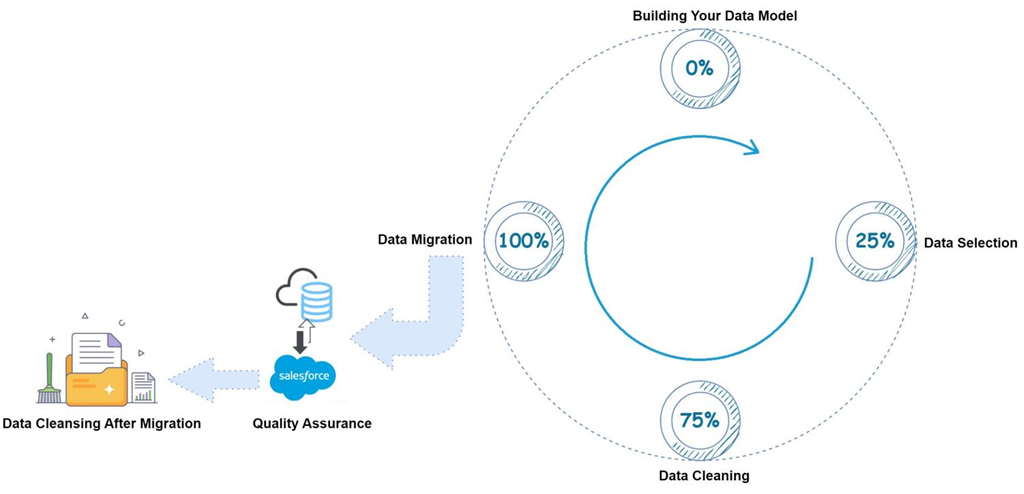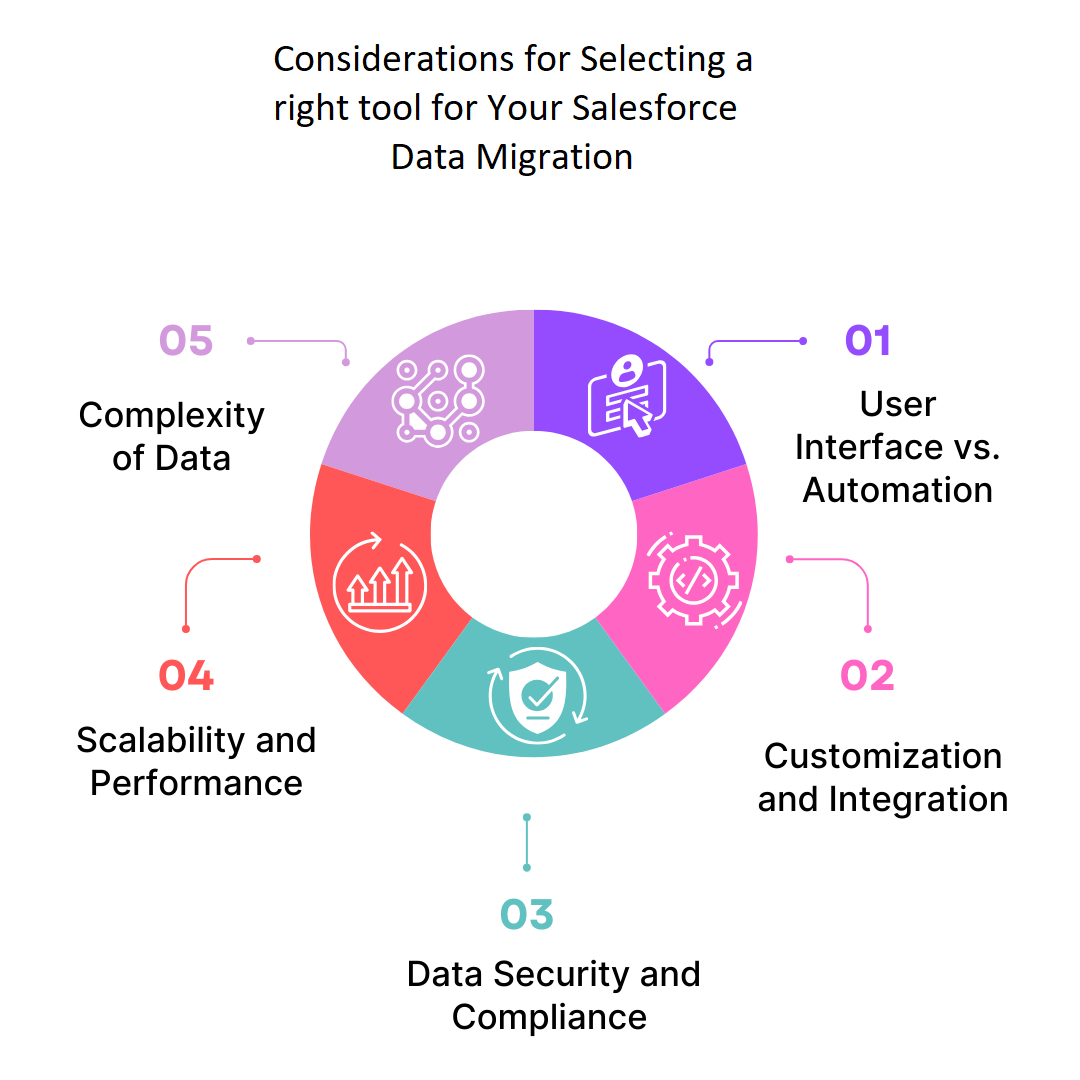Salesforce Data Migration Tools and Their Usage
Starting a Salesforce migration or updating to a newer version frequently entails the crucial stage of data migration. Seamless and accurate data migration is paramount for a successful Salesforce implementation. In this blog, we will explore various Salesforce data migration tools and their usage, helping organizations make informed decisions based on their specific needs.

Fig: Salesforce Data Migration Process
Salesforce Data Migration Tools Overview
- Data Loader:
Usage: Salesforce Data Loader is a more capable import wizard that allows for import, export, editing, and deletion. A variety of data objects, including custom ones, are imported by Data Loader.
Key Features:
- Efficient handling of enormous data quantities.
- Support for both simple and complex data transformations.
- Command-line interface for automation.
- Advantages:
- For the seasoned Salesforce specialist, quicker, more potent, and more settings.
- You can export, update, upsert, delete, and insert using it.
- Disadvantages:
- Steeper learning curve for non-technical users.
- A dataloader has to be downloaded to perform any operation.
- Schedule data import isn't possible.
- Data Import Wizard:
Usage: Data Wizard is a Salesforce base tool for data import in common standards as well as custom objects with user friendly interface.
Key Features:
- User-friendly, guided step-by-step process.
- Appropriate for users with different levels of technical skill.
- Advantages:
- Simple and easy to use, suitable for users with varying technical expertise.
- You can insert Contact and Account in one import
- Disadvantages:
- Limited functionality for complex data transformations.
- You cannot import data with a limit of 50000 records and a maximum file size of 100 MB.
- Workbench:
Usage: Workbench is a web-based, integrated suite of tools catering to Salesforce administrators and developers. It includes data migration capabilities.
Key Features:
- For Salesforce administration and development worked as a generic set of tools.
- Supports bulk data operations, including queries, inserts, updates, and deletions.
- Advantages:
- The user-friendly Workbench interface makes it possible to execute SOQL queries quickly and effectively, giving insightful information about databases.
- Supports queries, inserts, updates, and deletions of large amounts of data.
- Disadvantages:
- Could be overwhelming for users focused just on data migration.
- Requires familiarity with Salesforce APIs.
- Jitterbit:
Usage: A downloadable integration tool called Jitterbit's Salesforce Data Loader helps users synchronize data between Salesforce and other systems like databases, apps, and external services.
Key Features:
- User-friendly graphical interface.
- Advanced data transformation capabilities.
- Advantages:
- Undoubtedly, one of Jitterbit's most alluring features is the fact that it is "free." Furthermore, Jitterbit's free edition still has a ton of incredible features to get you started.
- Jitterbit supports any type of schedule to automate your task, from quarterly to hourly.
- Disadvantages:
- Extended advanced functionalities require additional costs.
- Requires some learning for optimal utilization.
- Informatica:
Usage: Informatica is an enterprise-grade data integration platform that includes Salesforce data migration capabilities.
Key Features:
- Robust features for enterprise-level data integration.
- One domain used for database processing
- Performance is good when running in a grid
- Advantages:
- Informatica has streaming scalability.
- Distribution of resources is better
- Disadvantages:
- Higher cost compared to other tools.
- May be overkill for small to medium-sized businesses with simpler migration needs.
Salesforce Data Migration Tools Usage
1. Data Loader:
Use Case: Ideal for organizations with large data volumes and complex transformation needs.
Best Practices:
- In Windows, for automated the data import use the command line interface.
- Leverage the bulk API for enhanced performance with large datasets.
2. Data Import Wizard:
Use Case: Suitable for smaller organizations or projects with simpler data migration requirements.
Best Practices:
- Utilize the wizard's guided process for straightforward data imports.
- For accuracy it confirms data mappings and transformations
3. Workbench:
Use Case: Suited for Salesforce administrators and developers requiring an integrated suite of tools.
Best Practices:
- Leverage the comprehensive tools beyond data migration for ongoing Salesforce management.
- For complex use cases that involve Salesforce API, use Workbench.
4. Jitterbit:
Use Case: Recommended for organizations requiring a user-friendly, graphical interface and advanced data transformation capabilities.
Best Practices:
- Resort the GUI for designing data integration workflows.
- The versatility of Jitterbit allows it to work with a variety of targets and data sources.
5. Informatica:
Use Case: Ideal for large enterprises with complex data integration needs beyond Salesforce.
Best Practices:
- Determine the scalability of Informatica for handling data volumes at an enterprise level.
- Leverage advanced data transformation features for intricate mapping requirements.
Selection of Right Tool for Your Salesforce Data Migration

Fig: Selection of Right Tool for Salesforce Data Migration
1. Size and Complexity of Data:
Data Loader or Jitterbit are used to process large datasets with complex transformations. For simpler migrations with smaller volumes, the Data Import Wizard might be sufficient.
2. User Skillset:
If your team includes non-technical users, tools like the Data Import Wizard or Jitterbit with user-friendly interfaces may be preferable. For developers and administrators comfortable with the command line, Data Loader or Workbench may be suitable.
3. Budget and Scale:
Examine your project's financial restrictions and scalability needs. Free tools like Data Loader or the Data Import Wizard may be sufficient for smaller projects, while larger enterprises may benefit from more comprehensive solutions like Informatica.
Salesforce Data Migration Considerations:
Choosing the best tools for Salesforce data migration is a crucial decision that has a significant impact on the success of the migration. Consider the following key factors when evaluating and choosing data migration tools for Salesforce:
- Data Volume and Complexity:
Consideration: The selection of an appropriate tool based on the volume of Entanglement of your data.
Guidance: For large data volumes or complex transformations, robust tools like Salesforce Data Loader or third-party ETL (Extract, Transform, Load) tools may be suitable. For smaller datasets with simpler requirements, the Salesforce Data Import Wizard might suffice.
- User Interface and Accessibility:
Consideration: Assess the technical expertise and preferences of your team members who will be involved in the data migration.
Guidance: For users with varying technical expertise or those who prefer a more user-friendly interface, tools like the Data Import Wizard or tools with graphical interfaces like Jitterbit may be preferable. If your team is technically proficient and comfortable with command-line interfaces, tools like Data Loader or Workbench may be suitable.
- Integration Capabilities:
Consideration: Evaluate whether your data migration involves integration with other systems beyond Salesforce.
Guidance: If your migration requires extensive integration capabilities, consider tools like Jitterbit or Informatica, which offer advanced features for integrating with various data sources.
- Data Transformation and Mapping:
Consideration: Evaluate how much complex mapping with data transformation is needed for your migration.
Guidance: For advanced data transformations, tools like Jitterbit or Informatica offer graphical interfaces for designing complex data integration workflows. Ensure that the selected tool supports the mapping requirements of your specific migration.
- Scalability:
Consideration: Consider the scalability requirements of your organization, especially if you anticipate future growth.
Guidance: Choose a tool that can adapt to your organization's data migration needs. Jitterbit and Salesforce Data Loader both possess remarkable scalability features.
- Security and Compliance:
Consideration: Examine the data migration tools' support for security features and compliance requirements.
Guidance: Ensure that the selected tool adheres to security best practices and complies with relevant data protection regulations. Salesforce-provided tools typically align with Salesforce's security standards.
Conclusion:
The choice of a data migration tool depends on various factors, including the size and complexity of your data, user skill set, and budget considerations. By understanding the features and best practices associated with each tool, organizations can make informed decisions to ensure a seamless and successful Salesforce data migration. The secret is to match the functionality of the tool with the needs of your Salesforce migration project, regardless of whether you choose the effectiveness of Data Loader, the intuitiveness of Data Import Wizard, or the sophisticated features of Jitterbit or Informatica.
To understand the use of data migration tools in Salesforce, get in touch with the Blueflame Labs to discuss the implementation with our Salesforce experts.











 Strictly Necessary Cookies
Strictly Necessary Cookies